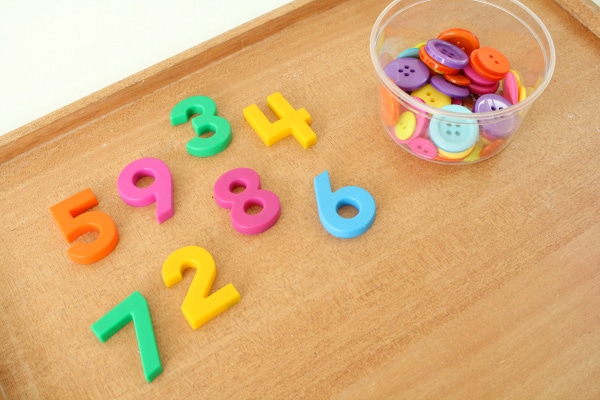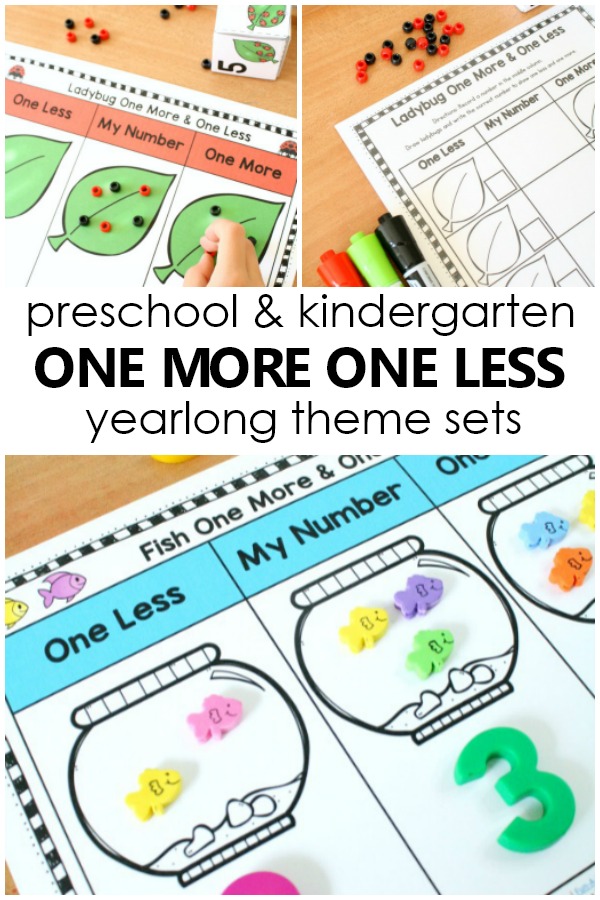As kids learn to count and create groups of items we can begin exploring number sense concepts like comparing and more and less. A deep understanding of these concepts is an important focal point of early childhood math instruction. In the past we’ve shared some of our favorite hands-on games to practice one more and one less during center time. Here I’m outlining quick prep one more one less number sense activities that you can use to introduce the concept of one more and one less with concrete materials. Personally I like to use these activities in a small group or one on one session.

One More One Less Number Sense Activities
This short video shows the three main activities shared in this post so you can see them done in action.
One More One Less Activity 1: Pom Pom Sets
For this activity you’ll need:
- Number cube-I like to start with a basic 6-sided die for these activities. Then as kids get more comfortable working with those numbers I’ll expand to a polyhedral dice options.
- Pom poms (I keep an assorted bin of poms poms as part of our DIY math manipulatives set)
- Sorting area-Here we are using wooden rings from our Spielgaben set. Small plates or trays would work well too.

To do this activity we:
- Roll the number cube.
- Create a set of pom poms with that number in the sorting circle to the right of the cube and then add one more. Starting with the set that is the same as was rolled and then adding in the extra pom pom helps kids visually and tactically experience the adding of one more.
- Create a set of pom poms with the number rolled in the circle to the left of the cube and then remove one pom pom to show one less. Here again starting with the number rolled and physically removing one pom pom helps kids understand what is taking place when we are identifying one less than another number…as opposed to just memorizing the information without awareness of what is really taking place.
- Count how many are in each set now.
- We wrap up by using our math vocabulary to describe what is happening (see the end of this post for more details about this step).

One More One Less Activity 2: Natural Materials and Play Dough
For this activity you’ll need:
- Play Dough
- Natural Materials-We’re using acorns and mini pine cones. Head outdoors to collect anything in your local area that will work.
- Number Stamps-We are using the ones from this play dough set,

To do this activity we:
- Choose a number stamp from the set and stamp it into the center of the dough. (This is a great opportunity to differentiate for kids while keeping the activity the same. Simply give different numbers to different kids.)
- Create a set of natural materials to the right of the stamped number and then add one more.
- Create a set of set of natural materials to the left of the stamped number and then remove one item to show one less.
- Count how many are in each set now.
- Describe what was done and our results using math vocabulary.

Note that adding in the play dough to this activity also incorporates some fine motor practice and sensory play. Not only does this make it a bit more fun for kids. It’s a helpful way to integrate a variety of early childhood focal points.

One More One Less Activity 3: Loose Parts and Magnetic Numbers
For this activity you’ll need:
- Magnetic Numbers
- Loose Parts of Your Choice-We’re using assorted buttons, but any small items you have on hand will work. Mini erasers, small toys, and flat beads also work well.

To do this activity we:
- Choose a number from the set and place it in the center of the workspace.
- Create a set of loose parts to the right of the magnetic number and then add one more.
- Create a set of set of loose parts to the left of the magnetic number and then remove one item to show one less.
- Count how many are in each set now.
- Describe what was done and our results using math vocabulary.

Using our math vocabulary to describe what is happening
Important note: I do specifically work with one more on the right and one more on the left intentionally. This mimics what kids will later see and use on a number line, and it helps prepare them for that.
As I mentioned above we finish out each activity by talking about what we have done. This is a key step and should not be skipped.
Not only do kids need to be able to find correct answers. They need to be able to explain their thinking and their strategies. Starting these conversations in the early years will help them be more comfortable with this expectation in the long run.
So what are we talking about, exactly?
First I always open with an open-ended invitation to share, so I’ll likely say something like:
- Tell me what you did here.
- Explain the steps you used.
- Walk me through what you did with these materials.
Then as we chat I’ll make sure we’ve explored more specific questions. Often the topics will be covered as the child explains, so I don’t ask all of these questions. However, I will use them as needed to keep extending the conversation.
Possible questions for these number sense activities:
- What number did you start with?
- How did you show one more/one less/?
- What number is one more than ___(child’s number)? How do you know that?
- What number is one less than ___ (child’s number)? How do you know that?
Also note that it is helpful to model for kids how to respond in a complete sentence using the math vocabulary.
If a child responds “4” to question number 3 above, I’d model back by saying, “Oh, I see. The number 4 is one more than 3.”
And for the next example I’d encourage the child to use that same sentence when responding. This is a gradual process and not something kids will do immediately, just something to work toward as they begin to understand the concept.
Continue the One More One Less Practice into Center Time
After you’ve introduced the concept of one more and one less in whole group and small group activities like the ones above you can provide kids with the opportunity for more practice with one more and one less games during center activities.
Get 15 One More One Less Sets to practice all year long. This gives preschoolers and kindergarteners the opportunity to develop a deep understanding of this important number sense skill.
Take a peek at some of the math game mats included in this set.





Krithika
Hi Shaunna,
Thank you so very much for sharing these amazing ideas and art!
I am newbie head teacher for a preschool and your website has been a great resource and help for my teaching journey.